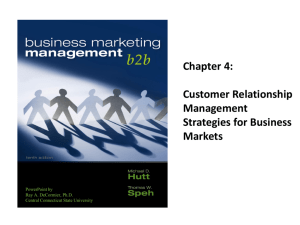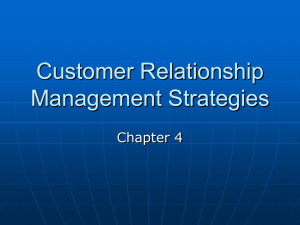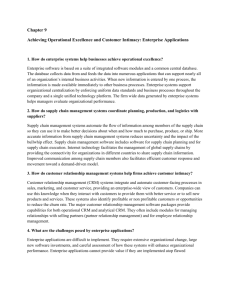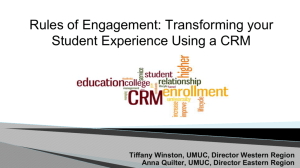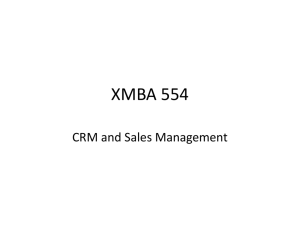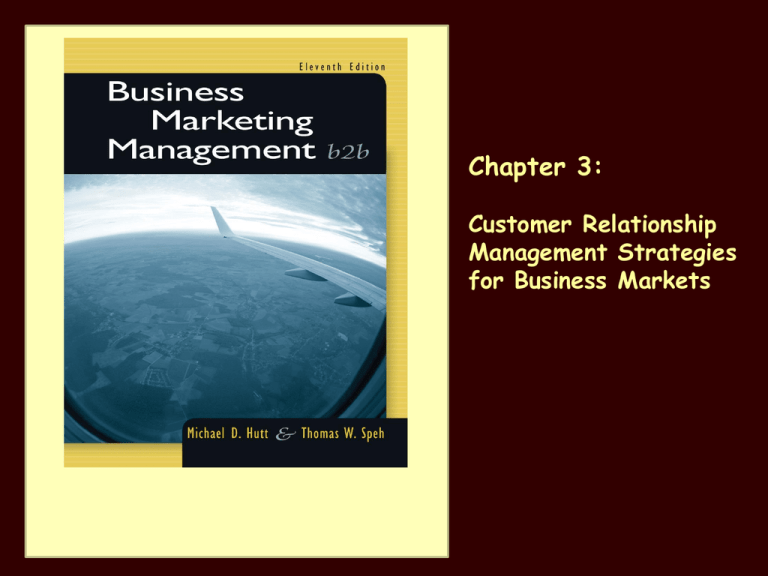
Chapter 3:
Customer Relationship
Management Strategies
for Business Markets
Relationship Marketing
Relationship Marketing centers on
Establishing,
Developing, and
Maintaining
successful exchanges with customers.
History of CRM
B&S
RM
CIMS
CRM
e-CRM
Time line
Late 80’s
Early 90’s
Mid 90’s
2002 - Future
B&S – Buying & Selling
RM – Relationship Marketing
CIMS – Customer Information Management Systems
CRM – Customer Relationship Management
e-CRM- A subset of CRM that focuses on enabling
customer interactions via e-channels (The web,
Definitions
“is a business strategy with outcomes
– that optimise profitability, revenue and customer
satisfaction
– by organizing around customer segments,
– fostering customer-satisfying behaviors and
– implementing customer-centric processes.”
“is a strategy
– used to learn more about customers' needs and
behaviors
– in order to develop stronger relationships with
them.”
Underpinning Theory
Customers have many points of contact with
an organisation
Retaining customers is far most cost effective
than recruiting new ones
Some customers are more profitable than
others
–
–
The “80/20” rule
For most firms, 80 percent of profit comes from 20
percent of customers
Use of Technology
Potential Benefits Of CRM
Customer retention
Share of customer or share of wallet
Cross-selling
Up-selling
Potential Costs Of CRM
IT infrastructure
Process change
Three phases of CRM
Acquiring New Relationships
– You acquire new customers by promoting your
company’s product and service leadership.
Enhancing Existing Relationships
– You enhance the relationship by encouraging
excellence in cross-selling and up-selling,
thereby deepening and broadening the
relationship.
Retaining Customer Relationships
– Retention focuses on service adaptability –
delivering not what the market wants but what
customers want.
Customer Types
Platinum Heavy, reliable users, not pricesensitive, try new products, loyal
Gold Large users who push for price breaks,
shop around and not so loyal
Iron Low volume or intermittent users; cost to
serve them is quite high
Lead Demanding, want special attention but
don’t buy much and show no loyalty
Types of Relationships
• Continuum of buyer-seller relationships
• Transactional, Value-added & Collaborative exchanges
The Relationship Spectrum
Transactional Exchange
Centers on timely exchange of basic products
at highly competitive market prices
These types of transactions are autonomous,
meaning that there is little or no concern as to
the needs of buyer or seller
Example: A person comes into a store and
buys a hammer. The buyer wants a hammer
and the seller sells him one. That’s all there
is to it!
Transactional Exchanges
The business market includes items like:
Packaging,
Cleaning products or
Commodity-type products or service
activity where bidding is employed.
Transactional exchanges employ an
Arms-Length relationship.
Occurs when alternatives are few, market is
dynamic, the purchase is complex and the
price is high
Features close information, social, and
operational linkages, as well as mutual
commitments
Switching costs are extremely important to
collaborative customers
Trust is the key and it exists when one party
has complete confidence in their partner’s
ability and integrity
Value-Added Exchanges
Value-Added Exchanges fall between
Transactional and Collaborative Exchanges
Value-Added Exchanges are those where the
selling firms shifts from just attracting
customers to keeping them by:
1.
2.
3.
Adding additional services
Developing services that are customized to meet
the buyer’s needs
Providing continuing incentives that promote
repeat business
The Element of Competition
Competition forces a war-like environment
whereby competitors are always trying to lure
customers from competitors.
Since customer situations (i.e., requirements,
expectations, people, preferences) change,
there is always opportunity for customers to
change from relationship to transactional to
relationship with new suppliers.
Effects of Market Conditions
Market conditions force different types of
relationships.
The marketer needs to understand this
aspect of business to determine which
strategy to employ with various markets.
What is the best strategy: transactional or
collaborative?
Switching Costs
•
•
A major consideration before changing from
one supplier to another is the switching costs.
Organizational buyers invest heavily in their
relationships with suppliers.
Investments include:
1. Money
2. People
3. Training Costs
4. Equipment
5. Procedures and processes
Switching Costs
Buyers hesitate to switch because it can cause
costly disruptions.
Risk of making a wrong choice of lessestablished suppliers can be costly.
From a marketing perspective, the prospect’s
PROBLEM must exceed the BENEFITS that
they are presently experiencing with their
current supplier before they will consider
switching.
Value Drivers in
Collaborative Relationships
Suppliers of routinely purchased products
offer three sources of value:
1. Value creation through core offerings
2. Value creation within the sourcing process
3. Value creation at the customers level of
operations
Furthering Collaborative Relationships
To develop ‘key supplier’ status, sellers need to:
Target the right customer.
Match with their purchasing situation.
Develop strategies that are appropriate for each type of
buyer . Collaborative buyers seek long, strong and
lasting relationships.
Buyers perceive significant risks with suppliers, so
competence and commitment are vital when starting
the relationship.
To improve customer loyalty and satisfaction,
many companies have developed specialized
services and customized products.
Question: Is this really profitable?
Differentiation Strategy
For a differentiation strategy to work:
“The value created, measured by higher
margins and higher sales volumes, has to
exceed the cost of creating and delivering
the customized features and services.”
To determine this, the marketer needs to
understand the drivers of profitability.
High- vs. Low-Cost-to-Serve Customers
High-Cost-to-Serve Customers
Low-Cost-to-Serve Customers
Order custom products
Order standard products
Order small quantities
Order large quantities
Unpredictable order arrivals
Predictable order arrivals
Customized delivery
Standard delivery
Frequent changes in delivery requirements
No changes in delivery requirements
Manual processing
Electronic processing (EDI)
(i.e., zero defects)
Large amounts of presales support
(i.e., marketing, technical, and sales resources)
Little to no presales support
(i.e., standard pricing and ordering)
Large amounts of post-sales support
(i.e., installation, training, warranty, field service)
No post-sales support
Require company to hold inventory
Replenish as produced
Pay slowly (i.e., high accounts receivable)
Pay on time
Source: Robert S. Kaplan and V.G. Narayanan, “p. 8. Measuring and Managing Customer Profitability,” Journal of Cost Management 15, No. 5
(September/October 2001):
Customer Profitably
As mentioned previously, some customers are
profitable and some aren’t. To determine this,
we look at the cost/profitability structure with
the plan to:
1.
2.
3.
Keep profitable customers
Convert unprofitable ones to profitability
Fire those who are not profitable
Customer Profitability
Figure 3.4
Net Margin Realized
High
Passive
Product is crucial
Good supplier match
Costly to service,
but pay top
dollar
Price-sensitive but
few special
demands
Aggressive
Leverage their buying power
Low price and lots of
customization
Most challenging
Low
Low
High
Cost-to-Serve
SOURCE: From “Manage Customers for Profits (Not Just Sales)” by B.P. Shapiro et al., September-October 1987, p. 104, Harvard Business Review.
Managing Unprofitable Customers
Low margin / high cost customers offer the
most challenge for marketing mangers.
Start with ways to reduce costs
Next, work with customers to possibly
change their actions resulting in lowering
costs or increasing profitability
Customer Retention
Retention of profitable customers is
crucial to business. However, due to
competition and internal / external
environmental factors, achieving this goal
is difficult.
One method that is proving successful for
customer retention is the use of CRM
programs.
Customer Relationship Management
Customer Relationship Management (CRM)
is a cross-functional process for achieving:
a.Continuing
dialog with customers across
all contact and access points
b.Personalized service to the most valuable
customers
c.Increased customer retention
d.Continued marketing effectiveness
CRM Technology
CRM programs are software systems that capture
information and integrate sales, marketing and
customer service information.
CRM programs can gather information from many
sources including email, call centers, service and
sales reps.
The information is available to the right people in
the organization in real time.
CRM Software Programs
There are many types of CRM programs:
1. Some companies develop their own
proprietary programs.
2. Some companies purchase off-the-shelf
programs.
Responsive Strategies
A
CRM program cannot help
unless a company employs the
proper strategy to secure and
retain profitable customers.
Special
attention must be given
to five areas.
CRM Strategy - Priorities
1. Acquire the right customer.
2. Craft the right value proposition.
3. Institute the best processes.
4. Motivate employees.
5. Learn to retain customers.
Account selection demands a clear
understanding of:
1.
2.
3.
4.
5.
Seller’s resources
Customer’s needs
Cost of serving various groups of
customers
Potential profit opportunities
How customers define value and how
to meet those expectations
What do customers value?
Some demand low price
Some demand customer service
Some demand quick delivery
The question is: “Can the seller
deliver it profitably?”
Many sellers try to meet all their
customer’s needs, and may do so,
but fail to do it profitably.
#2 – Crafting the Right Value
Proposition
A value proposition encompasses the
products, services, ideas and solutions that
a business marketer presents to the
prospect/customer that is designed to solve
the customers’ problems.
They can be generic or customized.
Value Proposition
A value proposition may include:
1. Points of parity to a competitive option
2. Points of difference
Best practice suppliers base their value
proposition on their target market’s needs by
communicating their offering of superior
performance in a way that conveys they
understand their customer’s business
priorities.
Value Proposition Strategies
Strategies that competitors employ fall
into a range referred to as:
“Industry Bandwidth of Working
Relationships”
It ranges from pure transactional to pure
collaborative exchanges (see Fig. 4.5 on
the next slide).
Flaring Out Strategy
‘Flaring
out’ strategy (Fig 4.5b) states that
the seller can either unbundle (point A),
that is, reduce the service associated with
a lower price (transactional in nature), or
Augment
by adding more services to the
core offerings (point D) which adds cost to
the services. This is collaborative in
nature.
Creating Customized Products
The seller starts with a core
service (“naked solutions”) and
adds customized services to it
(“custom wrapped”) that create
more value.
#3 - Institute Best Practices
The sales force plays a key role in establishing and
growing a customer from a transactional account to
a collaborative partnership.
They can do this by aligning and deploying technical
and service support units to match with their
customers’ units.
Technical groups can consist of research, logistics
and customer service units.
Through careful management and screening,
transactional accounts can progress to
partnerships.
1.
2.
3.
In addition to using best practices, successful
organizations (like IBM) employ follow-up
techniques such as:
Assigning a client representative to take
ownership of the relationship.
Assigning a Project Owner who completes the
project or solves project problems.
Developing an in-process feedback and
measurement system.
#4 - Motivating Employees
Dedicated employees are the key to a
successful customer relationship strategy.
The best approach is to:
1.Hire good people.
2.Invest in them to increase their value to
the company and its customers.
3.Develop challenging careers and align
incentives to performance measures.
Why Retain Loyal Customers?
Established customers buy more.
Cost of serving loyal customers declines.
Less expensive than acquiring new customers.
#5 - Retaining Customers
Retain customers by:
• Providing superior value (more than expected) to
ensure high satisfaction.
• Nurturing trust.
• Developing mutual commitment.
• If possible, helping customers grow their business.
How to Pursue Growth from
Existing Customers
Identify and cultivate customers that offer
the most growth potential by:
1.Estimating current percent “share of
wallet”
2.Pursuing opportunities to increase share
3.Projecting and enhancing customer
profitability
Evaluating Relationships
Some relationship-building efforts fail because
expectations of the parties don’t mesh.
Example: Seller wants a business relationship
whereas the customer responds in a
transactional mode.
By understanding and isolating customer
needs, the marketer is better equipped to
match their product offerings to a particular
customer’s needs.
Drivers of RM Effectiveness:
Definitions
• Relationship Quality: High-caliber relational
bond characterized by commitment and trust
• Relationship Breadth: Number of interpersonal
ties that connect the relationship
• Relationship Composition: Portfolio of
contacts ranging from low-level influencers to
high-level decision makers
• Relationship Strength: The ability of the buyerseller relationship to withstand stress and/or
conflict
• Relationship Efficacy: The ability of an interfirm relationship to achieve desired objectives
Developed by Cool Pictures and MultiMedia Presentations
Copyright © 2007 by South-Western, a division of Thomson Learning, Inc. All rights reserved.


